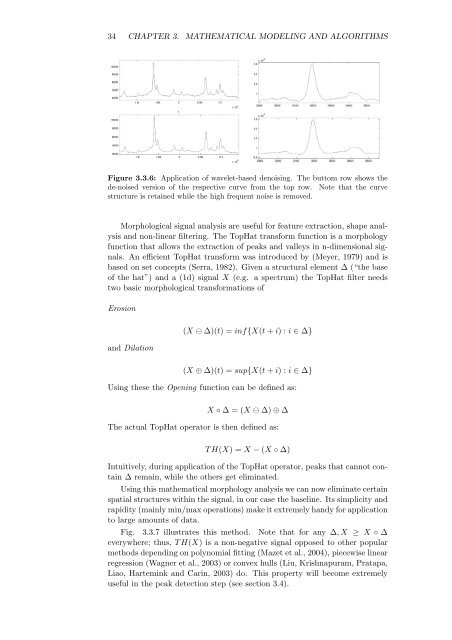New Statistical Algorithms for the Analysis of Mass - FU Berlin, FB MI ...
New Statistical Algorithms for the Analysis of Mass - FU Berlin, FB MI ...
New Statistical Algorithms for the Analysis of Mass - FU Berlin, FB MI ...
You also want an ePaper? Increase the reach of your titles
YUMPU automatically turns print PDFs into web optimized ePapers that Google loves.
34 CHAPTER 3. MATHEMATICAL MODELING AND ALGORITHMS<br />
Figure 3.3.6: Application <strong>of</strong> wavelet-based denoising. The buttom row shows <strong>the</strong><br />
de-noised version <strong>of</strong> <strong>the</strong> respective curve from <strong>the</strong> top row. Note that <strong>the</strong> curve<br />
structure is retained while <strong>the</strong> high frequent noise is removed.<br />
Morphological signal analysis are useful <strong>for</strong> feature extraction, shape analysis<br />
and non-linear filtering. The TopHat trans<strong>for</strong>m function is a morphology<br />
function that allows <strong>the</strong> extraction <strong>of</strong> peaks and valleys in n-dimensional signals.<br />
An efficient TopHat trans<strong>for</strong>m was introduced by (Meyer, 1979) and is<br />
based on set concepts (Serra, 1982). Given a structural element ∆ (“<strong>the</strong> base<br />
<strong>of</strong> <strong>the</strong> hat”) and a (1d) signal X (e.g. a spectrum) <strong>the</strong> TopHat filter needs<br />
two basic morphological trans<strong>for</strong>mations <strong>of</strong><br />
Erosion<br />
and Dilation<br />
(X ⊖ ∆)(t) = inf{X(t + i) : i ∈ ∆}<br />
(X ⊕ ∆)(t) = sup{X(t + i) : i ∈ ∆}<br />
Using <strong>the</strong>se <strong>the</strong> Opening function can be defined as:<br />
X ◦ ∆ = (X ⊖ ∆) ⊕ ∆<br />
The actual TopHat operator is <strong>the</strong>n defined as:<br />
T H(X) = X − (X ◦ ∆)<br />
Intuitively, during application <strong>of</strong> <strong>the</strong> TopHat operator, peaks that cannot contain<br />
∆ remain, while <strong>the</strong> o<strong>the</strong>rs get eliminated.<br />
Using this ma<strong>the</strong>matical morphology analysis we can now eliminate certain<br />
spatial structures within <strong>the</strong> signal, in our case <strong>the</strong> baseline. Its simplicity and<br />
rapidity (mainly min/max operations) make it extremely handy <strong>for</strong> application<br />
to large amounts <strong>of</strong> data.<br />
Fig. 3.3.7 illustrates this method. Note that <strong>for</strong> any ∆, X ≥ X ◦ ∆<br />
everywhere; thus, T H(X) is a non-negative signal opposed to o<strong>the</strong>r popular<br />
methods depending on polynomial fitting (Mazet et al., 2004), piecewise linear<br />
regression (Wagner et al., 2003) or convex hulls (Liu, Krishnapuram, Pratapa,<br />
Liao, Hartemink and Carin, 2003) do. This property will become extremely<br />
useful in <strong>the</strong> peak detection step (see section 3.4).









